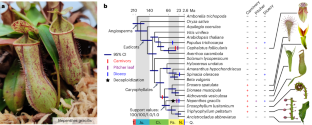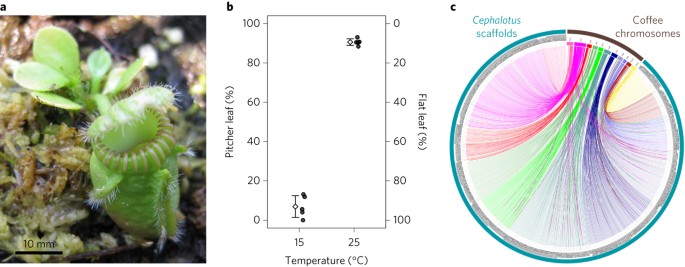2023-11-23 バッファロー大学(UB)
◆アジアのネペンテスは、この突然の遺伝子コピーの変異によって、獲物を捕らえる能力や食欲の調節が微調整されている可能性があります。研究は、ネペンテスの遺伝子組み換えによって新機能が進化する過程を理解するとともに、染色体の重複(多倍体性)が新しい機能の進化を促すことを示しています。
<関連情報>
- https://www.buffalo.edu/news/releases/2023/11/how-carnivorous-Asian-pitcher-plants-acquired-signature-insect-traps.html
- https://www.nature.com/articles/s41477-023-01562-2
- https://www.nature.com/articles/s41559-016-0059
- https://www.science.org/doi/10.1126/science.1523408
サブゲノム優勢が十倍体ピッチャー植物ネペンテス・グラシリスの新たな遺伝子進化を形作る Subgenome dominance shapes novel gene evolution in the decaploid pitcher plant Nepenthes gracilis
Franziska Saul,Mathias Scharmann,Takanori Wakatake,Sitaram Rajaraman,André Marques,Matthias Freund,Gerhard Bringmann,Louisa Channon,Dirk Becker,Emily Carroll,Yee Wen Low,Charlotte Lindqvist,Kadeem J. Gilbert,Tanya Renner,Sachiko Masuda,Michaela Richter,Gerd Vogg,Ken Shirasu,Todd P. Michael,Rainer Hedrich,Victor A. Albert & Kenji Fukushima
Nature Plants Published:23 November 2023
DOI:https://doi.org/10.1038/s41477-023-01562-2

Abstract
Subgenome dominance after whole-genome duplication generates distinction in gene number and expression at the level of chromosome sets, but it remains unclear how this process may be involved in evolutionary novelty. Here we generated a chromosome-scale genome assembly of the Asian pitcher plant Nepenthes gracilis to analyse how its novel traits (dioecy and carnivorous pitcher leaves) are linked to genomic evolution. We found a decaploid karyotype and a clear indication of subgenome dominance. A male-linked and pericentromerically located region on the putative sex chromosome was identified in a recessive subgenome and was found to harbour three transcription factors involved in flower and pollen development, including a likely neofunctionalized LEAFY duplicate. Transcriptomic and syntenic analyses of carnivory-related genes suggested that the paleopolyploidization events seeded genes that subsequently formed tandem clusters in recessive subgenomes with specific expression in the digestive zone of the pitcher, where specialized cells digest prey and absorb derived nutrients. A genome-scale analysis suggested that subgenome dominance likely contributed to evolutionary innovation by permitting recessive subgenomes to diversify functions of novel tissue-specific duplicates. Our results provide insight into how polyploidy can give rise to novel traits in divergent and successful high-ploidy lineages.
ウツボカズラ植物セファロタスのゲノムが肉食に関連する遺伝的変化を明らかにするGenome of the pitcher plant Cephalotus reveals genetic changes associated with carnivory
Kenji Fukushima,Xiaodong Fang,David Alvarez-Ponce,Huimin Cai,Lorenzo Carretero-Paulet,Cui Chen,Tien-Hao Chang,Kimberly M. Farr,Tomomichi Fujita,Yuji Hiwatashi,Yoshikazu Hoshi,Takamasa Imai,Masahiro Kasahara,Pablo Librado,Likai Mao,Hitoshi Mori,Tomoaki Nishiyama,Masafumi Nozawa,Gergő Pálfalvi,Stephen T. Pollard,Julio Rozas,Alejandro Sánchez-Gracia,David Sankoff,Tomoko F. Shibata,Shuji Shigenobu,Naomi Sumikawa,Taketoshi Uzawa,Meiying Xie,Chunfang Zheng,David D. Pollock,Victor A. Albert,Shuaicheng Li & Mitsuyasu Hasebe
Nature Ecology & Evolution Published:06 February 2017
DOI:https://doi.org/10.1038/s41559-016-0059

Abstract
Carnivorous plants exploit animals as a nutritional source and have inspired long-standing questions about the origin and evolution of carnivory-related traits. To investigate the molecular bases of carnivory, we sequenced the genome of the heterophyllous pitcher plant Cephalotus follicularis, in which we succeeded in regulating the developmental switch between carnivorous and non-carnivorous leaves. Transcriptome comparison of the two leaf types and gene repertoire analysis identified genetic changes associated with prey attraction, capture, digestion and nutrient absorption. Analysis of digestive fluid proteins from C. follicularis and three other carnivorous plants with independent carnivorous origins revealed repeated co-options of stress-responsive protein lineages coupled with convergent amino acid substitutions to acquire digestive physiology. These results imply constraints on the available routes to evolve plant carnivory.
食虫植物: 系統発生と構造進化 Carnivorous Plants: Phylogeny and Structural Evolution
Victor A. Albert,Stephen E. Williams,and Mark W. Chase
Science Published:11 Sep 1992
DOI:https://doi.org/10.1126/science.1523408
Abstract
The carnivorous habit in flowering plants represents a grade of structural organization. Different morphological features associated with the attraction, trapping, and digestion of prey characterize a diversity of specialized forms, including the familiar pitcher and flypaper traps. Phylogenetic analysis of nucleotide sequence data from the plastid rbcL gene indicates that both carnivory and stereotyped trap forms have arisen independently in different lineages of angiosperms. Furthermore, these results demonstrate that flypaper traps share close common ancestry with all other trap forms. Recognition of these patterns of diversification may provide ideal, naturally occurring systems for studies of developmental processes underlying macromorphological evolution in angiosperms.


